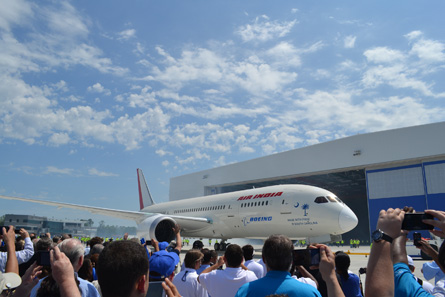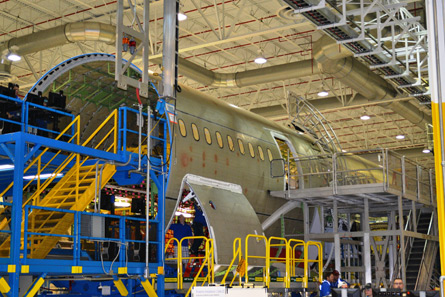Having turned out its first complete Boeing 787, the airframer's South Carolina facility will have to accelerate production by the end of 2013.
Six thousand non-unionised and contract workers build aft sections and assemble fuselage mid-sections for all 787s, but the Charleston-based arm is on the hook to build 10 mid-sections and 10 aft sections per month - up from the current 3.5/month - plus three complete aircraft, compared with fewer than one currently.
The Charleston final assembly line rolled out its first 787-8 (Airplane 46) on 27 April 2012, which is destined to join Air India in late June. The company plans to deliver four aircraft in total this year, all to the Indian airline.
 |
|---|
© John Croft/Flightglobal Air India will be the recipient of the first four jets to roll out of the Charleston assembly facilities |
From a financial standpoint, a rapid rise in production is necessary for the 787 programme. With a steady production rate of 10/month before 2014, Boeing maintains that there will be an inflection point in 2015 where costs to build a 787 dip below the average sales price, beginning the process of paying back an estimated $20 billion in deferred production costs. As of 27 April, Boeing had delivered 11 787s.
SAVINGS DOUBTS
Some analysts question the viability of Boeing's ability to cut its unit cost that quickly. Investment house UBS says 2015 is overly optimistic, and assumes Boeing will bring 787 manufacturing costs down 50% faster than for the 777.
To bring manufacturing costs down, higher-rate production must go hand-in-hand with decreasing amounts of travelled work - tasks left open for later completion to keep the line moving. Boeing South Carolina manager Jack Jones says the first 787 completed at Charleston left the factory with 96 travellers: "A couple of hundred is not unusual."
A key element in this low figure for Airplane 46 is that the aircraft does not need the typical post-production change incorporations that 787s on the primary line in Everett, Washington, continue to require. Those include engineering change orders to correct for items uncovered during flight testing. The Charleston final assembly line has the advantage of coming on line with those changes incorporated into the production process from the start.
Boeing South Carolina's manager of mid-body assembly, Willy Geary, says the latest mid-body, for Airplane 67, was shipped on 27 April to the final assembly line in Everett with only five open work items.
Part of the speed equation for Geary is converting his three parallel lines - designated A, B and C - to "continuously moving lines" from static operations where workers assemble sections 43, 11 and 45, flown from Nagoya, Japan, and sections 44 and 46 from Italy. The mid-body line also installs environmental and electrical systems into the section and performs testing.
MODELLING EVERETT
Geary says line C will be converted to a continuously moving line later this year, followed by lines A and B, when the 10 mid-bodies/month rate is set to be achieved in late 2013. Geary says he is "studying" production rates above 10/month.
Charleston's aft-body assembly manager, Matt Borland, says a fourth broaching machine being installed will enable the ramp up, in six-month increments, to meet Boeing's overall monthly target of 10 787s by the end of 2013. Composite sections 47 and 48 - the aft fuselage - are wound, baked, framed, joined and built up with floors, windows and other installations in Borland's building. Most are shipped to Everett, but an increasing number will be kept at Charleston for line production.
 |
|---|
© John Croft/Flightglobal Monthly mid-section production rates need to rise from 3.5 to 10 |
Broaching machines automatically drill holes in the fuselage sections and install fasteners for the frames and other items that will be attached to the barrel. Loaded in two of the three operational machines on 27 April were aft fuselages for Airplanes 75 and 76. Three Air India 787s, in various states of assembly, were on the line.
Modelled after the primary line in Everett, the Charleston line will ramp up to produce three 787s per month, complementing the seven built in Everett by late 2013. Boeing South Carolina final assembly and delivery manager Marco Cavazzoni says the final assembly building "has potential for expansion if we need to do that".
"We asked you to build three aircraft per month," Boeing Commercial Airplanes chief executive Jim Albaugh said to the assembled crowd of workers and VIPs at the inaugural Charleston 787 roll-out. "If you can build more, I guarantee we can sell more."
Source: Flight International



















